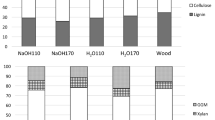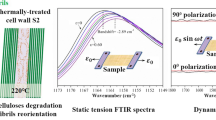Abstract
Dynamic Fourier Transform Infra-Red (FT-IR) spectroscopy was used to examine the interactions among cellulose, xyloglucan, pectin, protein and lignin in the outer fibre wall layers of spruce wood tracheids. Knowledge regarding these interactions is fundamental for understanding the fibre separation in a mechanical pulping process. Sheets made from an enriched primary cell wall material were used for studying the viscoelastic response of the polymers. The results indicated that strong interactions exist among lignin, protein, pectin, xyloglucan and cellulose in the primary cell wall. This signified a closely linked network structure of the components on the fibre surface. This ultrastructural arrangement in the primary cell wall and the relatively high content of lignin, pectin and protein in it, means that the primary cell wall is more submissive to selective chemical attacks, when compared to the secondary cell wall. A low ratio of cellulose Iα to cellulose Iβ in the primary cell wall was also found.









Similar content being viewed by others
Abbreviations
- FT-IR:
-
Fourier Transform Infra-Red
- TMP:
-
Thermomechanical pulp
- CTMP:
-
Chemithermomechanical pulp
- P:
-
Primary cell wall
- S1 :
-
Outer secondary cell wall
- CSF:
-
Canadian standard freeness
- BDDJ:
-
Britt dynamic drainage jar
- S2 :
-
Middle secondary cell wall
- RH:
-
Relative humidity
- DMA:
-
Dynamic mechanical analysis
- CP/MAS 13C-NMR:
-
Cross-polarization magic angle spinning carbon-13 nuclear magnetic resonance
References
Agarwal UP, Ralph SA (1997) FT-Raman spectroscopy of wood: identifying contributions of lignin and carbohydrate polymers in the spectrum of black spruce (Picea mariana). Appl Spectrosc 51(11):1648–1655
Åkerholm M, Hinterstoisser B, Salmén L (2004) Characterization of the crystalline structure of cellulose using static and dynamic FT-IR spectroscopy. Carbohydr Res 339(3):569–578
Åkerholm M, Salmén L (2001) Interactions between wood polymers studied by dynamic FT-IR spectroscopy. Polymer 42(3):963–969
Åkerholm M, Salmén L (2002) Orientation and dynamic behaviour of lignin in the cell wall. In: Proceedings of Seventh European workshop on lignocellulosics and pulp, Åbo, Finland, pp 27–30
Åkerholm M, Salmén L (2003) The oriented structure of lignin and its viscoelastic properties studied by static and dynamic FT-IR spectroscopy. Holzforschung 57(5):459–465
Åkerholm M, Salmén L (2004) Softening of wood polymers induced by moisture studied by dynamic FT-IR spectroscopy. J Appl Polym Sci 94:2032–2040
Agarwal UP, Ralph SA, Atalla RH (1997) FT Raman spectroscopic study of softwood lignin. In: Proceedings of 9th international symposium on wood and pulping chemistry (ISWPC), Montreal, pp. 8-1–8-4
Atalla RH, VanderHart DL (1984) Native cellulose: a composite of two distinct crystalline forms. Science 223:283–285
Axelson P, Simonson R (1982) Thermomechanical pulping with low addition of sulfite. Part 1. Effects of mild sulfite treatment of spruce chips prior to defibration. Svensk papperstidning 85(15):R132–R139
Bacic A, Harris PJ, Stone BA (1988) Structure and function of plant cell walls. In: Preiss J (ed) The biochemistry of plants 14. Carbohydrates. Academic Press, New York, pp 297–371
Chen L, Wilson H, McCann MC (1997) Infra-red microspectroscopy of hydrated biological systems: design and construction of a new cell with atmospheric control for the study of plant cell walls. J Microsc 188:62–71
Christiane L (2005) Structures of hemicelluloses and pectins in wood and pulp. Helsinki University of Technology, Helsinki
Christiernin M (2006) Composition of lignin in outer cell-wall layers. Royal Institute of Technology, Stockholm
Collier W, Kalasinsky VF, Schulz TP (1997) Infrared study of lignin: assignment of methoxyl C-H bending and stretching bands. Holzforschung 51(2):167–168
Collier WE, Schultz TP, Kalasinsky VF (1992) Infrared study of lignin: reexamination of aryl-alkyl ether C-O stretching peak assignment. Holzforschung 46(6):523–528
Colthup NB, Daly LH, Wiberley SE (1990) Introduction to Infrared and Raman Spectroscopy. Academic Press Limited, London, pp 171–213
Faix O (1991) Classification of lignins from different botanical origins by FTIR Spectroscopy. Holzforschung 45(Supplement):21–27
Fengel D (1993) Influence of water on the OH valency range in deconvoluted FTIR spectra of cellulose. Holzforschung 47:103–108
Günzeler H, Gremlich H-U (2002) IR Spectroscopy. Wiley-VCH Verlag GmhH, Weinheim, pp 171–278
Harrak H, Chamberland H, Plante M (1999) A proline-, threonine-, and glycine-rich protein down-regulated by drought is localized in the cell wall of xylem elements. Plant Cell Physiol 121:557–564
Hedenberg Ö (1992) Mechanism of drum debarking. Royal Institute of Technology, Stockholm
Hinterstoisser B, Salmén L (1999) Two-dimensional step-scan FTIR: a tool to unravel the OH-valency-range of cellulose. Cellulose 6(3):251–263
Hinterstoisser B, Salmén L (2000) Application of dynamic 2D FTIR to cellulose. Vib Spectrosc 22:111–118
Hinterstoisser B, Åkerholm M, Salmén L (2001) Effect of fiber orientation in dynamic FTIR study on native cellulose. Carbohydr Res 334:27–37
Hortling B, Olsson A-M, Lucander M, Kleen M (2004) Characterization of surface material from latewood fractions of mechanical pulps. In: Proceedings of eight European workshop on lignocellulosics and pulp. Utilization of lignocellulosics and by-products of pulping, Riga, Latvia 562 pp, pp 81–84
Hult E-L, Liitiä T, Maunu S, Horting B, Iversen T (2001) A CP/MAS 13C-NMR study of cellulose structure on the surface of kraft pulp fibers. In: Hult E-L (ed) CP/MAS 13C-NMR Spectroscopy applied to structure and interaction studies on wood and pulp fibers. Royal Institute of Technology, Stockholm, pp 1–15
Irvine GM (1984) The glass transitions of lignin and hemicellulose and their measurement by differential thermal analysis. Tappi J 67(5):118–121
Ishii T, Shimizu K (2001) Chemistry of cell wall polysaccharides. In: David NS, Hon N-S (eds) Wood and cellulosic chemistry. Marcel Dekker, Inc., Basel, pp 175–241
Kataoka Y, Kondo T (1996) Changing cellulose crystalline structure in forming wood cell wall. Macromolecules 29:6353–6358
Larsson T, Westermark U, Iversen T (1995) Determination of the cellulose Ia allomorph content in a tunicate cellulose by CP/MAS 13C-NMR spectroscopy. Carbohydr Res 278:339–343
Larsson PT, Wickholm K, Iversen T (1997) A CP/MAS 13C NMR investigation of molecular ordering in celluloses. Carbohydr Res 302:19–25
Lawoko M, Henriksson G, Gellerstadt G (2006) Characterisation of lignin-carbohydrate complexes (LCCs) of spruce wood (Picea abies L.) isolated with two methods. Holzforschung 60:156–161
Liang CY, Marchessault RH (1959) Infrared spectra of crystalline polysaccharides. I. Hydrogen bonds in native celluloses. J Polym Sci 37:385–395
Olsson A-M, Salmén L (2003) The softening behavior of hemicelluloses related to moisture. In: Gatenholm P, Tenkanen M (eds) ACS Symp ser.864 hemicelluloses: science and technology. American Chemical Society, Washington, pp 184–197
O’Neill M, Albersheim P, Darvill A (1990) The pectic polysaccharides of primary cell wall. Methods Plant Biochem 2:415–441
Salmén L, Olsson A-M (1998) Interaction between hemicelluloses, lignin and cellulose: structure–property relationships. J Pulp Paper Sci 24(3):99–103
Salmén L, Petterson B (1995) The primary wall; important for fibre separation in mechanical pulp. Cellul Chem Technol 29:331–337
Sugiyama J, Persson J, Chanzy H (1991) Combined infrared and electron diffraction study of the polymorphism of native cellulose. Macromolecules 24:2461–2466
Tashiro K, Kobayashi M (1991) Theoretical evaluation of three-dimensional elastic constants of native and regenerated celluloses: role of hydrogen bonds. Polymer 32(8):1516–1526
Tokoh C, Takabe K, Fujita M, Saiki H (1998) Cellulose synthesized by Acetobacter xylinum in the presence of acetyl glucomannan. Cellulose 5:249–261
Westermark U, Samuelsson B, Simonson R, Pihl R (1987) Investigation of a selective sulfonation of wood chips. Part 5. Thermomechanical pulping with low addition of sulfite. Nordic Pulp Paper Res J 4:146–151
Whitney SEC, Gidley MJ (1999) Roles of cellulose and xyloglucan in determining the mechanical properties of primary plant cell walls. Plant Physiol 121:657–663
Wickholm K, Larsson PT, Iversen T (1998) Assignment of non-crystalline forms in cellulose I by CP/MAS 13C NMR spectroscopy. Carbohydr Res 312:123–129
Yamamoto H, Horii F (1994) In situ crystallization of bacterial cellulose I. Influences of polymeric additives, stirring and temperature on the formation of cellulose IA and IB as revealed by cross polarization/magic angle spinning (CP/MAS) 13C NMR spectroscopy. Cellulose 1:57–66
Yamamoto H, Horii F, Hirai A (1996) In situ crystallization of bacterial cellulose II. Influences of different polymeric additives on the formation of cellulose Iα and Iβ at the early stage of incubation. Cellulose 3:229–242
Acknowledgements
This work was carried out within the framework of the Wood Ultrastructure Research Center (WURC) at Uppsala, Sweden, financed by VINNOVA, the Nordic pulp and paper industry and SLU. The authors wish to express their gratitude to Dr. Margaretha Åkerholm for precious advice concerning the dynamic FTIR spectroscopy. We are indebted to Ms. Joanna Hornatowska for kindly carrying out the light microscopy images. Dr. Tomas Larsson is especially acknowledged for performing the NMR measurements and valuable discussions.
Author information
Authors and Affiliations
Corresponding author
Rights and permissions
About this article
Cite this article
Stevanic, J.S., Salmén, L. Characterizing wood polymers in the primary cell wall of Norway spruce (Picea abies (L.) Karst.) using dynamic FT-IR spectroscopy. Cellulose 15, 285–295 (2008). https://doi.org/10.1007/s10570-007-9169-1
Received:
Accepted:
Published:
Issue Date:
DOI: https://doi.org/10.1007/s10570-007-9169-1




